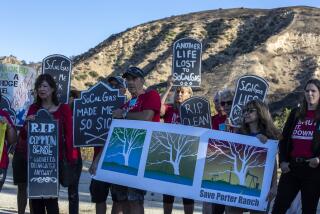Panel OKs Final Permit Allowing Use of Oil Tankers
- Share via
Despite last-ditch arguments from environmentalists and commercial fishermen, the California Coastal Commission granted the final permit needed for Chevron Corp. to begin using oil tankers off the Ventura County coast.
At a hearing Wednesday in San Diego, the commission voted 8 to 3 to approve operation of the Gaviota Interim Marine Terminal, where Chevron and its partners in the Point Arguello offshore oil field plan to load the tankers.
All that remains is for the state Lands Commission to renew the lease of the terminal site, which all parties expect to occur in late March or early April. Shipments between Santa Barbara and Los Angeles could begin by late spring.
The Gaviota Terminal Co., which owns the facility, had asked for a three-year permit to load 100,000 barrels of crude oil a day. The commission on Wednesday agreed to only 50,000 barrels daily. Chevron has asked for this interim use of tankers while a land-based pipeline is built to carry the oil to Los Angeles.
The tankers will each carry about the
same amount of oil as was spilled in the 1989 Exxon Valdez spill. About one tanker will travel the route every five days under the current plan. Gaviota Terminal Co., operated by Texaco Trading & Transportation Inc., is owned by Texaco, Chevron, Exxon Corp. and Dallas-based Oryx Energy Co.
In January, the commission approved Chevron’s most critical permit--the right to use tankers in coastal waters. Wednesday’s approval had been considered routine, but the commission faced a barrage of questions from environmentalists and Santa Barbara commercial fishermen. They raised a long list of concerns, ranging from fears of health hazards from the radar system that will track the ships to whether fish are harmed or scared away by the noise from a dropping anchor.
A few commissioners shared the environmentalists’ contention that the Gaviota Terminal permit should have been considered at the same time or before Chevron’s permit to tanker. Separate consideration, they said, did not allow them to discuss the interlocking environmental and safety issues of both parts of the tanker plan. However, approving the permit to use tankers in effect left the commission with little choice but to approve the terminal’s operation, they said.
“We said yes to the devil last month and now we’re dealing with its tail,” said Commissioner Lily Cervantes, who opposed both permits.
Still, after a lengthy technical debate--and numerous minor changes to the permit provisions negotiated on the spot between representatives of the oil companies, Santa Barbara County and the commissioners--the commission approved the Gaviota permit.
Many opponents remain suspicious that Chevron and its partners in the end will avoid supporting a pipeline and will press to make tanker traffic permanent along the coast. Shipping the oil by tanker is cheaper than paying the cost of building a pipeline.
In any event, both permits require the use of tankers to stop by Jan. 1, 1996, regardless of whether a pipeline has been built.
The double-hull tankers that Chevron must use will be monitored for the entire length of the voyage and must stay within traffic corridors or face up to $30,000 a day in fines.
The oil producers also must keep records of all voyages, leave the tankers in port in bad weather and maintain a standby tug near Los Angeles in case a vessel needs assistance.
Commercial fishermen who supported the permit testified that the fish that they had encountered were not perturbed or frightened away even by the air bubbles from scuba diving equipment. Also, several witnesses said that no studies exist to prove health dangers from the proposed radar units.
Commissioner Dorill Wright, saying he had had some experience with military radar, dismissed the radiation hazard as minuscule to fishermen in offshore waters.
The commission wasn’t the proper body to address health questions, said Commission Executive Director Peter M. Douglas, “but nothing in the permit says the radar system can’t be changed.”
Linda Krop, staff attorney with the Santa Barbara-based Environmental Defense Council, representing several environmental groups, said environmentalists will appear at the Lands Commission hearing to protest renewing the terminal lease. She said environmentalists are also looking at the possibility of suing the Coastal Commission over the January shipping permit awarded Chevron and its partners, possibly on grounds that it violates provisions of Santa Barbara’s local coastal plan.
“We’ve been at this for a long time,” said Dan Mihalik, project manager of Gaviota Terminal Co., referring to the five-year attempt to get a terminal permit.
But even when Chevron begins to ship by tanker, in late spring or early summer, the tanker wars won’t be over. Exxon Corp., which has an offshore field just south of Chevron’s, began the permit-approval process for its own interim tankers in December with an application to Santa Barbara County. Unlike Chevron, however, Exxon wants to use single-hulled tankers, and to continue their use for as long as five years.
More to Read
Sign up for Essential California
The most important California stories and recommendations in your inbox every morning.
You may occasionally receive promotional content from the Los Angeles Times.









